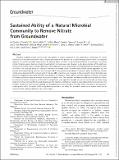| dc.contributor.author | Paradis, Charles J | |
| dc.contributor.author | Miller, John I | |
| dc.contributor.author | Moon, Ji-Won | |
| dc.contributor.author | Spencer, Sarah J | |
| dc.contributor.author | Lui, Lauren M | |
| dc.contributor.author | Van Nostrand, Joy D | |
| dc.contributor.author | Ning, Daliang | |
| dc.contributor.author | Steen, Andrew D | |
| dc.contributor.author | McKay, Larry D | |
| dc.contributor.author | Arkin, Adam P | |
| dc.contributor.author | Zhou, Jizhong | |
| dc.contributor.author | Alm, Eric J | |
| dc.contributor.author | Hazen, Terry C | |
| dc.date.accessioned | 2023-01-26T14:18:00Z | |
| dc.date.available | 2023-01-26T14:18:00Z | |
| dc.date.issued | 2022 | |
| dc.identifier.uri | https://hdl.handle.net/1721.1/147720 | |
| dc.description.abstract | Microbial-mediated nitrate removal from groundwater is widely recognized as the predominant mechanism for nitrate attenuation in contaminated aquifers and is largely dependent on the presence of a carbon-bearing electron donor. The repeated exposure of a natural microbial community to an electron donor can result in the sustained ability of the community to remove nitrate; this phenomenon has been clearly demonstrated at the laboratory scale. However, in situ demonstrations of this ability are lacking. For this study, ethanol (electron donor) was repeatedly injected into a groundwater well (treatment) for six consecutive weeks to establish the sustained ability of a microbial community to remove nitrate. A second well (control) located upgradient was not injected with ethanol during this time. The treatment well demonstrated strong evidence of sustained ability as evident by ethanol, nitrate, and subsequent sulfate removal up to 21, 64, and 68%, respectively, as compared to the conservative tracer (bromide) upon consecutive exposures. Both wells were then monitored for six additional weeks under natural (no injection) conditions. During the final week, ethanol was injected into both treatment and control wells. The treatment well demonstrated sustained ability as evident by ethanol and nitrate removal up to 20 and 21%, respectively, as compared to bromide, whereas the control did not show strong evidence of nitrate removal (5% removal). Surprisingly, the treatment well did not indicate a sustained and selective enrichment of a microbial community. These results suggested that the predominant mechanism(s) of sustained ability likely exist at the enzymatic- and/or genetic-levels. The results of this study demonstrated the in situ ability of a microbial community to remove nitrate can be sustained in the prolonged absence of an electron donor. | en_US |
| dc.language.iso | en | |
| dc.publisher | Wiley | en_US |
| dc.relation.isversionof | 10.1111/GWAT.13132 | en_US |
| dc.rights | Creative Commons Attribution 4.0 International license | en_US |
| dc.rights.uri | https://creativecommons.org/licenses/by/4.0/ | en_US |
| dc.source | Wiley | en_US |
| dc.title | Sustained Ability of a Natural Microbial Community to Remove Nitrate from Groundwater | en_US |
| dc.type | Article | en_US |
| dc.identifier.citation | Paradis, Charles J, Miller, John I, Moon, Ji-Won, Spencer, Sarah J, Lui, Lauren M et al. 2022. "Sustained Ability of a Natural Microbial Community to Remove Nitrate from Groundwater." Ground Water, 60 (1). | |
| dc.contributor.department | Massachusetts Institute of Technology. Department of Biological Engineering | en_US |
| dc.relation.journal | Ground Water | en_US |
| dc.eprint.version | Final published version | en_US |
| dc.type.uri | http://purl.org/eprint/type/JournalArticle | en_US |
| eprint.status | http://purl.org/eprint/status/PeerReviewed | en_US |
| dc.date.updated | 2023-01-26T14:14:51Z | |
| dspace.orderedauthors | Paradis, CJ; Miller, JI; Moon, J-W; Spencer, SJ; Lui, LM; Van Nostrand, JD; Ning, D; Steen, AD; McKay, LD; Arkin, AP; Zhou, J; Alm, EJ; Hazen, TC | en_US |
| dspace.date.submission | 2023-01-26T14:14:54Z | |
| mit.journal.volume | 60 | en_US |
| mit.journal.issue | 1 | en_US |
| mit.license | PUBLISHER_CC | |
| mit.metadata.status | Authority Work and Publication Information Needed | en_US |
